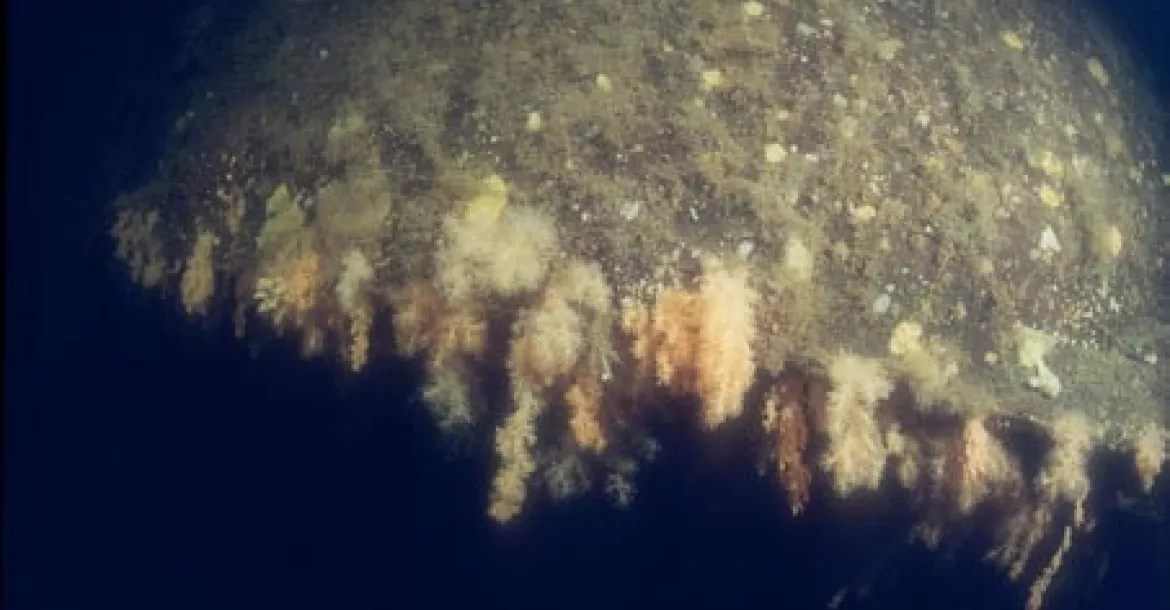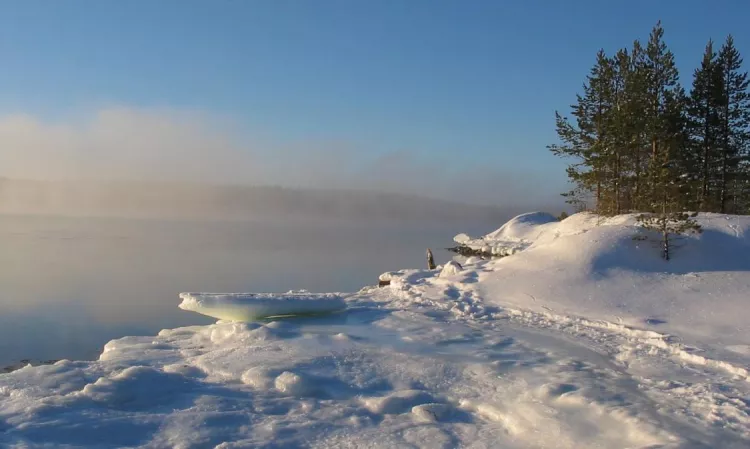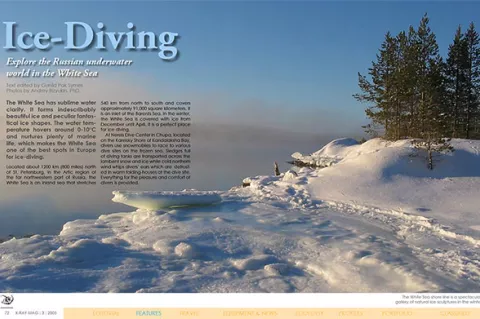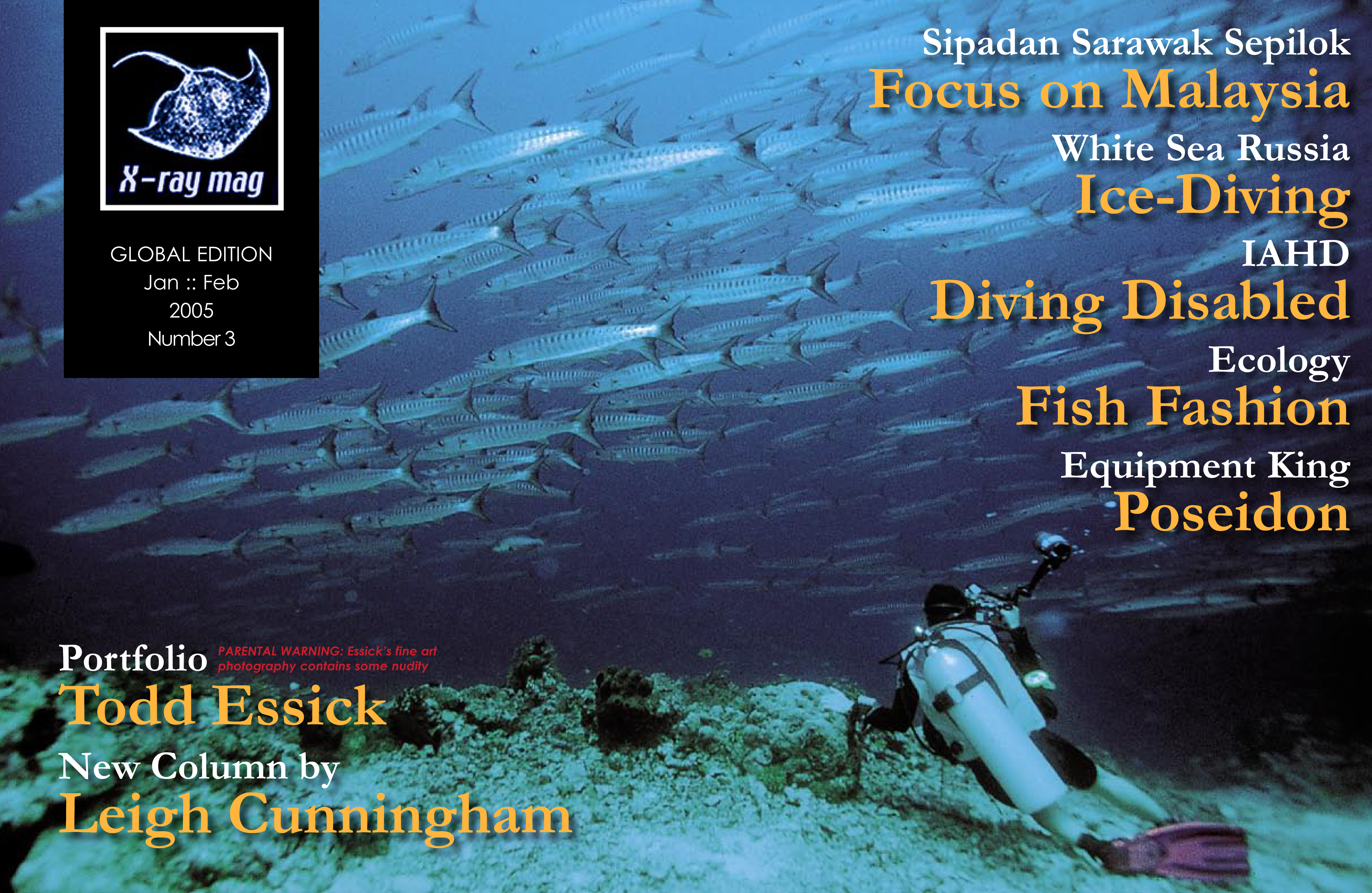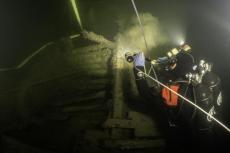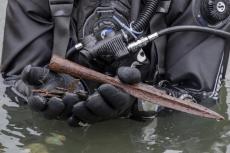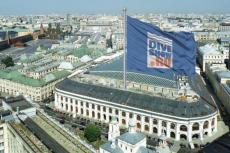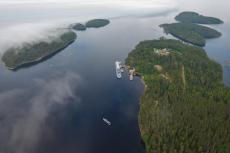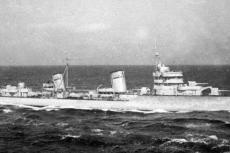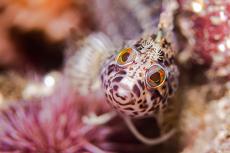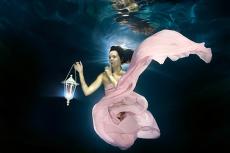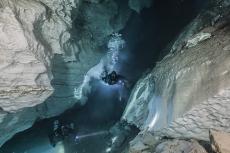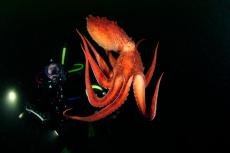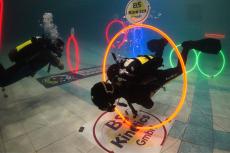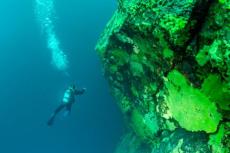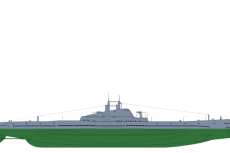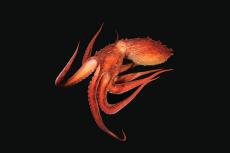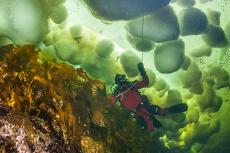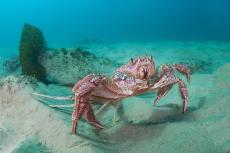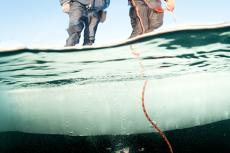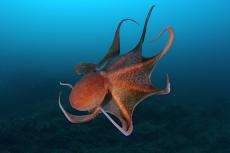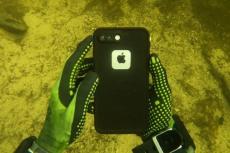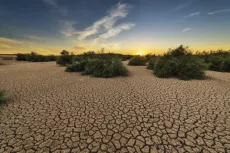The White Sea has sublime water clarity. It forms indescribably beautiful ice and peculiar fantastical ice shapes. The water temperature hovers around 0-10°C and nurtures plenty of marine life, which makes the White Sea one of the best spots in Europe for ice-diving.
Contributed by
Factfile
Alexandra Vlasova
March 8 is International Women’s Day. Let’s celebrate this day with an ice-dive! The dive site is situated not far from the hotel, near Chernishev Island. Perfect dry, sunny weather. It takes us only five minutes by snow-scooter to arrive at the dive site. My buddy, Julia Lonn, will have her first ice-dive, and I will have my first sea ice-dive.
After getting dressed in the warm house we do some planning near the ice-lane. The sun is beating down unmercifully. The snow is sparkling and the water attracts us with its incredible clarity. We are seated at the ice-lane edge and start descending quickly while trying to take our first breath underwater.
Located about 1200 km (800 miles) north of St. Petersburg, in the Arctic region of the far north-western part of Russia, the White Sea is an inland sea that stretches 540 km from north to south and covers approximately 91,000 square kilometres. It is an inlet of the Barents Sea. In the winter, the White Sea is covered with ice from December until April. It is a perfect place for ice diving. At Nereis Dive Center in Chupa, located on the Karelsky
Shore of Kandalaksha Bay, divers use snowmobiles to race to various dive sites on the frozen sea. Sledges full of diving tanks are transported across the lambent snow and ice while cold north-ern wind whips divers’ ears which are defrosted in warm folding-houses at the dive site. Everything for the pleasure and comfort of divers is provided.
The main attraction in this scenic land is the White Sea. There is a serene beauty in winter, with the sea’s undulating coastline where glacier movement has carved the landscape, fishing boats frozen along the shore, weather-worn cabins with wood smoke rising from their chimneys and the clinking silence above the ice-covered bays. The fauna of the sea is reflective of the temperate to arctic climate. Life thrives in a vivid and peculiar underwater world. Rocks are covered with soft corals, actinia and hydroids.
Cracks in between stones reveal lots of starfish, crabs, shrimps, hermit crabs and sleeping fish. Among the fish species are lancet fish, rockfish, flounder, herring and cod. White whales, seals, Greenland seals, sea-hares can also be spotted at the White Sea. The white whale is actually classified as a dolphin in Russia, even though Europeans consider it part of the whale family. Unlike dolphins, the white whale has active joints in the neck area that help it to easily turn its head. Above water, one can spot squirrels and hares, bear, wolf, lynx, deer and elk.
Bird watchers can find hazel-grouse, black-cock, partridge, wood-grouse, ducks, sandpipers and nesting ember geese at various times of the year. Deep and extensive forests of coniferous trees cover the region and filter the air. It is amazingly clean and fresh air.
Dive sites
A variety of dive sights and wrecks can be reached by one of the dive centre’s cutter ships within an hour or more from the base. Depending on the dive site and your qualifications, you can see a range of things, such as flat bottom landscapes with large kelp, sheer walls with actinia, ascidium, soft corals and bryozoa, small sea-urchins and White Sea crabs, lots of small sea animals, starfishes and a grotto.
Divers reach depths from 15 to 35 meters. The deeper the dive, the darker and colder it gets, so appropriate gear is a must. Wreck divers can explore a sunken fishing seiner on a shallow dive where numerous fish such as lancetfish, cod, rockfish, flounder, and small fishes make their home. Following are some of the most interesting dive sites to explore.
Chernyshov Island
(OSTROV CHERNYSHOV) Ten to 15 minutes from the dive centre is a dive site where soft corals grow densely along a rocky cape extending from a sandy precipice. Depth is 30-35 m. There are lots of ascidians and starfishes.
Deer Island Shipwreck
(OSTROV OLENIY) At 18 m, there is a shipwreck near Deer Island 30 minutes from the center. The wreck stands upright on its keel. Divers can explore the interior of the ship.
Korovya Varoka (the rock)
(KOROVYA VAROKA – MATERIK) Here, divers find wolf fishes, anemones, soft corals, shrimps, sea spiders, snails, mollusks and sea urchins. A wall leads to a heap of big stones with holes where the wolf fishes live. At 20m, a precipice drops to about 30-35 m beyond which lies a sandy bottom.
Kartesh Cape
(MYS KARTESH) This dive is made from a cutter moored to a rock at a location near the Marine Biology Station of the Academy of Science where there is a beautiful stream. Divers follow a stone precipice below which wolf fishes make their home in a bunch of large boulders. Sea anemones populate the area, and at 22 m, there are densely packed soft corals growing on the smooth slime bottom. Depth ranges from 30-35 m.
Sidorov Island
(OSTROV SIDOROV – MEZHOSTROVYE) Another dive made from a cutter at a location one and half hours from the dive centre, divers explore a strait between two big islands. One can dive there even during a storm. On Sidorov Island’s side there is a good stand. At 3-4 m depth, one will find lots of small fishes and a vertical wall leading to a depth of 18 m where ascidians and sponges grow. A bit further along, one can find wolf fish, cod, crabs and shrimps living at a stone precipice with big stones and holes. The maximum depth is 25 m.
Keret’ Island – Dry Rock
(OSTOV KKERET – SOOHAYA SKALA) Listed as “an ideal diving site for beginners and wives,” this location takes 40 minutes to reach by cutter from the dive center. At a stone precipice, divers can find lots of holes with wolf fishes. From 20 m, divers explore a sandy bottom covered with different types of starfishes. Directly below the moored cutter at 3-5 m, there is a beautiful carpet of anemones, which grow on a vertical wall.
(OSTROV KISHKIN – GROT)
About two hours from the centre, divers can enjoy cave diving at Kishkin Island. A vertical wall leads to a protruding rock at 20-22 m, which marks the entrance to the underwater cave. The cave’s ceiling is covered with a carpet of anemones and soft corals. As one continues through the cave, the ceiling lowers and the walls narrow. At the end of the cave, depth measures 35 m. The walls have cracks in them where divers can find sleeping perches hiding. The exit can be seen from all points in the cave, which has a length of 20m. Vertical walls flank the right and left sides of the cave entrance. The cutter moors to the rock above the cave.
The daily routine involves a casual but satisfying schedule. Divers get up in the morning, go upstairs to the dining hall to have a hot breakfast of crepes, bread and marmalade, oatmeal, coffee or tea and special dishes prepared with fresh catches from the White Sea. After breakfast, staff and divers load their gear onto transport vehicles and drive across the ice to the dive site.
Putting into the sea and getting to the dive site usually takes about one and a half to two hours. It is also possible to dive close to the base, thereby saving time in transportation
Then, there is the first dive, lunch at the island, second dive if desired and off you go back to base to a warm shower and a short snooze on a comfy bed in your cosy room at the hotel before it is time for dinner at the dive center’s restaurant.
Of course, after dinner, one must partake of the local customs and bond with one’s fellow dive buddies by sit-ting together and sweating in the beautifully constructed Russian birch-wood sauna on the ground floor of the center. Divers swap stories about diving the sea, and interesting anecdotes and tips are shared.
Personal accounts
Nobody tells a story better than those who experience ice-diving for themselves. Here are a couple of personal accounts from local divers to give you a glimpse into the wonders of the White Sea ice-div-ing experience.
Today, we went on a long trip to Cape Kartesh for a whole day. Snow scoot-ers rode easily across the deep-frozen snow. Most of the way we rode through the forest and finally found ourselves at the mouth of the Keret River. We were really amazed by the beauty of the non-freezing rapids, bright sun and blue sky. We ventured out to Chupa Bay on the White Sea where a friend of mine caught sight of several seals lying on ice blocks in the distance. At Cape Kartesh, the support team welcomed us – five people from the maintenance staff. The lanes were made, safety-lines were prepared, diving tanks and gear were waiting for the divers. Nearby there was a small, warm and comfy house. To say that we liked that dive is to say nothing! It was absolutely unbelievable and gorgeous!
Above all, there was the great visibility, which was more than 30 meters. The crystal clear waters gave us an opportunity to take in a view of an absolutely fantastic landscape – stony conglomerations with ledges, laminaria seaweed gardens to a depth of five meters, And, starting at 20 meters – a beautiful precipice (nobody knows how deep it is). From my position – I was almost at the end of the safety line – I could easily see other lanes and divers near them.
Moreover, comparatively thin ice (25 cm) and bright sun striking through it make wonderful enigmatic lighting effects. But the thing I really enjoyed was the shoreline. You cannot get the same view from the surface, but here there was an indescribable line of small and large pieces of ice broken up that created great patterns. According to the computer, the water temperature here was about minus 1-20 ̊C. That is why after 40 or 50 minutes in the water, one can feel a little bit cold.
After ascending to the surface, everybody felt amazed. We went to the house to warm up and have something to eat, and then hastened to make the next dive. There are so many things to look at underwater! It was a really perfect, amazing and unusual dive.
Going deeper along the wall and paying close attention to the kelp, one can see plenty of life around – starfish, actinia, polyps and soft corals. The purpose of this dive is not to go too deep, but to make an exploration of the ice (as much as possible). Because of ebbs and flows, the ice along the shore cracks and breaks, making underwater hummocks and small grottos. Sunshine is coming through the ice-cracks and shimmers with lots of colours. Air bubbles travelling inside the ice intensify the impression. We are so delighted! Let’s have some fun. Turning upside down we show each other figure skating. Unfortunately, time is up and we have to ascend.
On the surface, the guys from the support group salute us. Well done, ladies! We get changed, go back to the hotel and have a hot sauna. Fabulous, unforgettable memories, good friends and excellent vacations.
Requirements
There are some things divers need to know and prepare before coming to the Nereis Dive Center for the ice diving experience including specific equipment requirements, certification requirements and special services available at the centre. It is recommended that divers be certified with one of the major dive education schools such as CMAS, PADI, NAUI or IDD. Divers are encouraged to bring their own dry suits, regulators (DIN or YOKE), BCD, fins, mask and snorkel. There are convenient and very effective equipment drying rooms at the centre, two compressors and a decompression chamber. It is possible to upgrade your qualification and get your next CMAS certificate at the dive centre. One can also dive individually with an instructor.
The hotel, which was built by the owner-dive master, Yuri Borakov, and opened on July 15, 2003, offers double rooms, hot water, sauna and three meals a day in the hotel’s restaurant. With a friendly and personable staff, the Nereis Dive Center and Hotel is the most comfortable and practical way to go when taking on the adventure of ice-diving in some of the most beautiful and awe-inspiring wilderness of the great northwestern artic region of Russia.
As Nereis Dive Center is located in Chupa, a small Russian village with visible remnants of the Soviet past and multi-generational peasant life, visitors are treated with the greatest care and pride. All the staff are local and wish to share their joy in the natural beauty and culture of their region with divers from all over the world.
Not only will divers enjoy the natural beauty of the area and the White Sea, but divers will also experience the warmth and hospitality of the Russian people, their age-old customs and delicious hearty home-cooked meals, traditional folk song and dance, lively discussions and Russian wry wit and humour, as well as lots of the best caviar and vodka available to wan-dering adventurers on the planet. Nostrovia! ■
Published in
-
X-Ray Mag #3
- Läs mer om X-Ray Mag #3
- Log in to post comments

